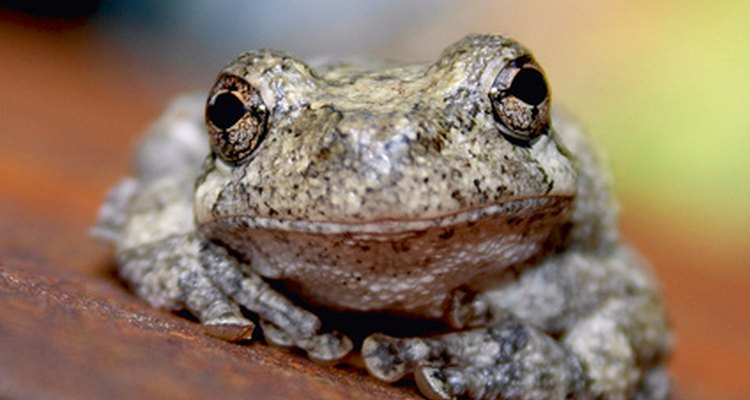
The frog has spiritual or cultural significance in nearly every historical population that has lived with it. Much of its symbolism derives from physical characteristics and survival tactics, while other frog-related symbols are based on things that the frog has little to do with, such as the acronym that can be derived from its name, or the fact that in some cultures the frog was seen as mysterious, magical, or was specially favored by certain gods. If you are considering getting a tattoo of a frog, it may interest you to know some of the symbols and meanings that have been attached to it at various times in history and cultures around the world. This permanent image on your body may or may not communicate what you intend.
Symbolism Based on Physical Characteristics
One of the reasons the frog has such a rich symbolic history is that its physical characteristics, survival adaptations, and breeding capability set it apart as an extraordinary creature. The transformation it undergoes from tadpole to adult is comparable only to the caterpillar in terms of total physical change, and when it is an adult, the frog can spawn thousands of tadpoles to continue the cycle. The amphibious nature of the frog allows it to live both in water and on land—even the tadpoles can live out of water if they remain moist—and in this way the frog has adapted itself to countries all over the world. A frog can jump 20 times its body length, and if it eats something poisonous it can regurgitate its whole stomach for cleansing. Given all of this, it is not difficult to understand why the frog is so often symbolic of fertility, energy, perseverance, metamorphosis, regeneration, rebirth, adaptability and healing.
Frog Symbolism in Western Cultures
Western cultures have historically not regarded the frog so highly. The shape of the frog's body, bulbous eyes, and the slime and warts that are so often associated with it have led the frog to be symbolically attached to unpleasant things. Fairy tales describe handsome princes being punished by being transformed into frogs. Literary tradition in Western cultures has also linked frogs to witches, the devil, plagues and disease. However, even in Western cultures, the frog has traditionally been seen as good luck, especially in gardens, and as a guard of the well.
The frog is also respected by the Haida. These are master totem pole carvers from Canada's west coast, and they often carved frogs to symbolize balance and harmony, both in houses and in relationships in general.
Ancient Frog Symbolism
Frog symbolism is by no means a new concept. Aphrodite, the Greek goddess of love and beauty, was supposed to have held the frog as sacred, and in ancient Egypt, some of the gods had the heads of frogs; Heket, the goddess of birth, was one. The ancient Egyptians revered frogs as being symbolic of life, as well as protectors on the journey after death, and for that reason frogs were embalmed and included in the tombs of royalty.
The ancient Tartars, too, held the frog as sacred. In their creation myths, it is the frog that brings man means of making fire. And the Iban in Borneo called the frog the creator of men. The most powerful of the Iban gods, Keling, would transform himself into a frog, and Iban ancestors return in a frog's body to return home. This culture also saw frog tattoos as protective; a frog tattoo on the throat was supposed to keep an Iban warrior from being decapitated in battle.
Special temples to honor the frog were built in some regions of China, and the green frog was considered a minor deity. To this day, some Chinese houses keep a frog with a coin in its mouth to symbolize prosperity in business.
Tribal Frog Symbolism
For North American coastal tribes, the frog is symbolic of prosperity and wealth. In their folkore, "Frog Woman" guards fresh water and created dams to control the water for man's benefit. The frog is "the Great Rain Maker" for many Native American tribes, and because frogs do not appear until spring, they are also symbolic of the end of winter and the beginning of new life.
Frogs are also an important as an ancient and magical animal totem in the Native American tradition. Simplified, an animal totem is a symbolic object that is used to connect people to nature and to make them whole. Totems aren't necessarily animals, but they are always guides that come into a person's life either long or short term to instruct and protect the person as he or she travels through life, both physically and spiritually. Animal totems are not chosen, but you can become aware of the right totem for you by paying attention to which animals you have a strong affinity for, which ones you're interested in, and sometimes, whether you have recurring dreams about a particular animal. This is based on the understanding that certain objects or animals resonate with us for some reason, and we are naturally drawn to them.
Religious and Philosophical Frog Symbolism
In animistic cultures (cultures that hold that there are spirits in all things including animals, plants, geographic formations, and natural occurrences, such as thunder), the shamans often saw frogs as teachers and guides that could help a person understand higher powers. The frog was representative of the magic involved in attaining new, higher levels of consciousness, and it was called upon in rituals and ceremonies.
In the Christian tradition, frogs are sometimes worn as a reminder of the acronym F.R.O.G: Fully Rely On God.
Related Articles

What Is an Italian Horn?

Why Do Brides Wear Veils?

What Does a Purple Iris Symbolize?

The Meaning of Wedding Bands

What Is the Meaning of White China Jade ...

What Feathers Mean to the Cherokee

How Do Oysters Protect Themselves?

The Meaning of a White Orchid

Hawaiian Traditional Gifts

The Meaning of Exchanging Wedding Rings

What Is the Meaning of Men Piercing ...

What Is the Meaning of Feather Tattoos?

List of the Types of Semi-Precious ...

Types of Masonic Rings

Ribbon Meanings for a Handfasting ...

Why Do Flower Girls Drop Petals?

The Purpose of Christening

History of Military Hats

Information on Carnival Masks

Traditional Korean Colors
References
Writer Bio
Sharon Grey has been a freelance writer since 2008. Her work has appeared in Elance and crowdSPRING. Grey has a Bachelor of Science in speech communications and studio art. She graduated summa cum laude from Black Hills State University in 2003.
Photo Credits
frog image by Dwight Davis from Fotolia.com